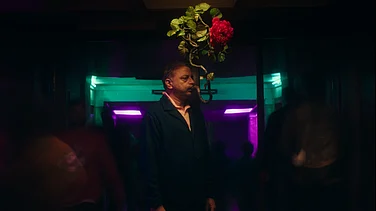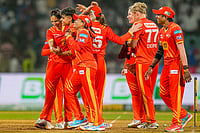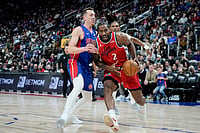'There is an extraordinary love story in every jodi' proclaimed the publicityfor Rab Ne Bana Di Jodi, Aditya Chopra's box-office winner, which markedhis return as the high priest of Hindi film romance -- a position he first wonwith Dilwale Dulhania Le Jayenge. Jodi broke the mould in moreways than one; and sometimes disturbingly so. Anushka Sharma is forced into amarriage with well-meaning dweeb Shah Rukh Khan, but cannot bring herself tolove him, thus prompting him to get an alpha male alter ego who sweeps the girloff her feet. Alas, Khan's character is so disturbed by this that he develops afeeling that his wife is cheating on him with another man, convenientlyforgetting that his wife's lover is none other than he himself. If we factor inthe fact that Anoushka's character is fooled by the removal of spectacles, amoustache and the addition of hair gel and gaudy T-shirts into believing thather lover is a different man, we have here a couple who would keep an army ofshrinks in business for years.
The annals of Hindi popular cinema are littered with romances that areatypical, if not quite reaching the bizarre heights of Jodi. Given thehistory of the subcontinent, one of the fascinations for filmmakers has been theHindu-Muslim romance, a subject forbidden enough for directors to turn to againand again. While films like Anil Sharma's Gadar, Yash Chopra's Veer-Zaaraand Randhir Kapoor's Henna took the safe way out and made the maleSikh/Hindu and the female Muslim (and Pakistani to boot), Chandra PrakashDwivedi, using Amrita Pritam's excellent novel as a base, turned the tables in Pinjarand made the male protagonist (Manoj Bajpai) a Muslim whilst Urmila Matondkarplayed the Hindu female. Recently, Ashutosh Gowariker followed suit with JodhaaAkbar where the Muslim emperor Akbar (Hrithik Roshan) marries the Hinduprincess Jodhaa (Aishwarya Rai-Bachchan) in a strategic alliance. Interestingly,while the Chopra and Kapoor films are treated as straightforward romances, withthe protagonists swearing undying love for each other fairly quickly, in Sharma's,Dwivedi's and Gowariker's films at least one half of the couple has to learn howto love the other over some period of time.

Hrithik and Aishwarya in Jodhaa Akbar
So, on to the love that dare not speak its name, namely incest. In Raj Khosla'sBambai Ka Babu, due to various circumstances, Dev Anand has toimpersonate someone and he falls in love with that character's sister SuchitraSen, leading to an incest scenario, which, of course, is not real. Similarly, inRavi Chopra's Zameer, the impersonator Amitabh Bachchan falls in lovewith his 'sister' Saira Banu. These however, were contrived circumstances. A farmore real scenario was enacted in J.P. Dutta's underrated Yateem, whereSunny Deol's foster father, Kulbhushan Kharbanda, marries a much younger woman,Sujata Mehta. The trouble is that Deol's new stepmother lusts after her virile,handsome, muscular stepson, makes advances to him and cries rape when spurned. Apotential incest quagmire was explored in K. Balachander's Ek Nai Paheli,a remake of his own Tamil film Apoorva Raagangal. Here, a young KamalHaasan falls in love with the older Hema Malini and they plan to marry. But,throwing a spanner in the works is the revelation that Hema's daughter PadminiKolhapure is planning to marry an older man Raaj Kumar, who happens to be KamalHaasan's father. Incest, real and not contrived this time, happens in SukhwantDhadda's Ek Chadar Maili Si, where after the death of his elder brother,Rishi Kapoor is forced to marry his sister-in-law Hema Malini, whom he hadalways looked up to as an elder sister.
Another Paheli, or conundrum, is posed by director Amol Palekar in hisadaptation of Viyayan Detha's story, earlier adapted by Mani Kaul as Duvidha.In this scenario, a newly married Rani Mukherji is distraught when her husbandShah Rukh Khan has to go away on business for five years. Much to her delight,he returns in a few days, but she doesn't know that in reality it is aninfatuated ghost who has taken her husband's shape. Love blooms between theghost Khan and Mukherji and soon she is pregnant. Of course, matters come to ahead when the real husband returns.

Urmila Matondkar and Manoj Bajpai in Pinjar
The older man-younger woman theme and vice versa is another well-exploredtopic amongst Hindi filmmakers. In Ramesh Talwar's Doosara Aadmi, theolder Rakhee falls in love with the younger Rishi Kapoor as she sees in himelements of her deceased husband Shashi Kapoor; while in Farhan Akhtar's DilChahta Hai, Akshaye Khanna is smitten with the older Dimple Kapadia. On theother hand the 60+ Amitabh Bachchan falls for the 30-something Tabu in Balki's CheeniKum and the 18-year-old Jiah Khan in Ram Gopal Verma's Nishabd. Noslouch in the older man stakes, Victor Banerjee is attracted to the much youngerPerizaad Zorabian in Anant Balani's Jogger's Park.
Hindi films have also explored different aspects of love within the confinesof a marriage. In Basu Chatterjee's gentle Piya Ka Ghar, the newlymarried Anil Dhawan and Jaya Bhaduri are very much in love, but are unable toconsummate their relationship, living as they do amidst a joint family in a tinyapartment. In Manik Chatterjee's Ghar, matters are altogether moreserious as married couple Vinod Mehra and Rekha must rediscover theirrelationship after she has been abducted and gang-raped. The presence of anex-boyfriend within a marriage has been explored in films like Basu Chatterjee'sSwami, Bapu's Woh Saat Din (based on K. Bhagyaraj's Andha EzhuNatkal) and Sanjay Leela Bhansali's Hum Dil De Chuke Sanam where ShabanaAzmi, Padmini Kolhapure and Aishwarya Rai respectively must choose between theirboyfriends (Vikram, Anil Kapoor and Salman Khan) and their husbands (GirishKarnad, Naseeruddin Shah and Ajay Devgan). In these cases conservatism prevailsand the staid husbands are chosen over the maverick boyfriends.

And finally, on to the love that dares speak its name in Hindi cinema thesedays -- homosexuality. While films like Deepa Mehta's Fire and KaranRazdan's Girlfriend have portrayed lesbianism head on, and Kamal Amrohi'sRazia Sultan portrayed Parveen Babi erotically caressing Hema Malini,their male counterparts have been rather more coy, usually mining the theme forlaughs rather than issues. Abhishek Bachchan and John Abraham managed aconvincing pretend gay act in Tarun Mansukhani's Dostana, and Shah Rukhand Saif Ali Khan's so-called gay subtext in Nikhil Advani's Kal Ho Naa Howas hilariously sent up by the actors themselves at the Filmfare Awards. On amore serious note, Onir tackled homosexuality and HIV in My Brother Nikhilwhile Sridhar Rangayan's Gulabi Aaina, which focuses on two transsexualsand a gay teen trying to seduce a straight man, remains banned in India. MaheshDattani's English-language gay-themed Mango Souffle, starring AtulKulkarni, remained largely unseen in India. As for the central male-malerelationship in India's most celebrated film Sholay, it is best describedin the words of Ted Sheen, writing in the Chicago Reader who says, "themale bonding borders on camp." To add to this debate, Sunaina Kumar, writingin the Indian Express, heralded the rise of the 'Bhai-sexual' in Hindifilms saying, "The Bhai-sexual shares a chemistry with his best pal that ofteneven overshadows his chemistry with his lady love."
Worth discussing.
Naman Ramachandran is the author of Lights, Camera, Masala: MakingMovies in Mumbai. A shorter, edited version of this appears in print

























